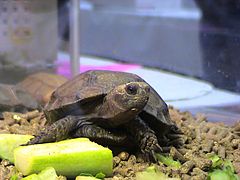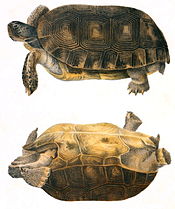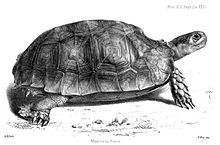- Asian forest tortoise
-
Asian forest tortoise 
Juvenile mountain tortoise, Manouria emys Conservation status Scientific classification Kingdom: Animalia Phylum: Chordata Class: Reptilia Order: Testudines Family: Testudinidae Genus: Manouria Species: M. emys Binomial name Manouria emys
(Schlegel & Müller, 1844)Asian forest tortoise (Manouria emys), also known as Asian brown tortoise, is a species of tortoise found in India (Assam), Bangladesh, Burma (or Myanmar), Thailand, Malaysia and Indonesia (Sumatra, Borneo).
Contents
Description
The largest tortoise in mainland Asia; large adult of the northern subspecies, M.e. phayrei, can reach 25 kg in the wild and much more than that in captivity. Shell considerably depressed, its depth not half its length; anterior and posterior margins reverted, more or less strongly serrated; nuchal present; supracaudal shields two; dorsal shields concentrically striated, often concave; vertebrals much broader than long and at least as broad as costals. Plastron large, gular region somewhat produced and usually notched, hind lobe deeply notched; the pectoral shields may be widely separated from each other, or from a short median suture; axillary shield very small, inguinal large. Head moderate; two large prefrontal shields and a large frontal; beak not hooked; jaws feebly denticulated, the alveolar surface of the upper jaw with a strong median ridge. Fore limb anteriorly with very large, bony, pointed, imbricate tubercles, forming four or five longitudinal series; hind limb with very large bony tubercles on the plantar surface, with others larger, conical, and spur-like on the heel, and a group of still larger conical tubercles on each side on the back of the thighs. Adult dark brown or blackish; carapace of young yellowish brown, with dark-brown markings.
Believed to be among the most primitive of living tortoises, based on molecular and morphological studies. This is the only tortoise which lays its eggs above ground in a nest, which the female constructs of leaf litter. The female uses both front and rear legs to gather material for the nest and lays up to 50 eggs deep inside it. She then sits on and near the nest to protect it, and will 'chase' predators and intruders away. [1]
Subspecies
- Manouria emys emys: S Thailand, Malaysia, Sumatra, Borneo; Type locality: Sumatra. M. e. emys has separated pectoral scutes while M. e. phayrei has joined pectoral scutes.
- Manouria emys phayrei: N/W Thailand to NE India; Type locality: Arakan; Tenasserim Provinces'. M. e. phayrei has been named after Sir Arthur Purves Phayre (1812-1885), British Army officer in India who became Commissioner of British Burma.
Cited references
- ^ Boulenger, G.A.(1890) Fauna of British India. Reptilia and Batrachia.
Other references
- Asian Turtle Trade Working Group (2000). Manouria emys. 2006. IUCN Red List of Threatened Species. IUCN 2006. www.iucnredlist.org. Retrieved on 11 May 2006. Listed as Endangered (EN A1cd+2cd v2.3)
- Anderson, J. 1871 On Testudo Phayrei, Theob. & Dr. Gray. Ann. Mag. Nat. Hist. (4) 8: 324-330
- Blyth, E. 1854 Notices and descriptions of various reptiles, new or little-known. Part I. J. Asiat. Soc. Bengal 22 [1853]: 639-655
- Schlegel, H. & Müller, S. 1844 Over de Schildpadden van den Indischen Archipel. In: Temminck,V. (1839-1847) Verhandelingen over de natuurlijke geschiedenis der Nederlandsche overzeesche bezittingen, door de leden der Natuurkundige Commisie in Oost-Indie en andere schrijvers. Leijden folio. Afd. 1 Zoologie in 12 afleveringen, met 45 gekl. pl. - Vitg. door C.J. Temminck, Leiden, Leuchtmans u. Hoeck in comm.: 29-36
- Stoliczka, F. 1871 Note on Testudo Phayrei. Ann. Mag. Nat. Hist. (4) 8: 212
External links
Tortoise family of turtles (Testudinidae) Genus 
Aldabrachelys Astrochelys Chelonoidis Chersina Cylindraspis† Geochelone Gopherus Homopus Beaked cape tortoise · Berger's cape tortoise · Boulenger's cape tortoise · Karoo cape tortoise · Speckled padloper tortoiseIndotestudo Elongated tortoise · Forsten's tortoise · Travancore tortoiseKinixys Bell's hinge-back tortoise · Forest hinge-back tortoise · Home's hinge-back tortoise · Lobatse hinge-back tortoise · Natal hinge-back tortoise · Speke's hinge-back tortoiseMalacochersus Manouria Psammobates Pyxis Stigmochelys Testudo Phylogenetic arrangement of turtles based on turtles of the world 2010 update: annotated checklist of taxonomy, synonymy, distribution and conservation status. Key: †=extinct. 1=classification unclear Order Testudines (turtles) Kingdom: Animalia · Phylum: Chordata · Class: Reptilia · Subclass: Anapsida · Order: Testudines Suborder SuperfamilySubfamily
Cryptodira Caretta · Chelonia · Eretmochelys · Lepidochelys · NatatorDermochelysDermatemydidaeDermatemysStaurotypinaeBatagur · Cuora · Cyclemys · Geoclemys · Geoemyda · Hardella · Heosemys · Leucocephalon · Malayemys · Mauremys · Melanochelys · Morenia · Notochelys · Orlitia · Pangshura · Rhinoclemmys · Sacalia · Siebenrockiella · VijayachelysAldabrachelys · Astrochelys · Chelonoidis · Chersina · Cylindraspis · Geochelone · Gopherus · Homopus · Indotestudo · Kinixys · Malacochersus · Manouria · Psammobates · Pyxis · Stigmochelys · TestudoTrionychiaCarettochelyidaeCarettochelysTrionychinaePleurodira ChelidinaeChelodininaeHydromedusinaePhylogenetic arrangement based on turtles of the world 2010 update: annotated checklist. Extinct turtles not included.
See also List of Testudines families
 Portal ·
Portal ·  WikiProjectCategories:
WikiProjectCategories:- IUCN Red List endangered species
- Manouria
- Reptiles of India
- Fauna of Borneo
- Reptiles of Bangladesh
- Reptiles of Burma
- Reptiles of Vietnam
- Reptiles of Cambodia
- Reptiles of Thailand
- Reptiles of Indonesia
- Reptiles of Malaysia
- Animals described in 1844
Wikimedia Foundation. 2010.


